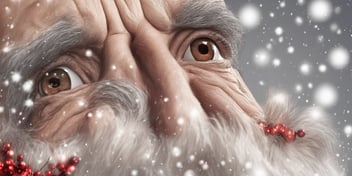- Blog
- Christmas questions
- Who is Santa Claus, and where did the legend come from?

Every holiday season, children around the world eagerly await the arrival of a jolly, bearded figure dressed in a red suit, spreading joy and gifts.
Yes, we are talking about none other than Santa Claus! But have you ever wondered who this magical figure really is, and how he became the beloved symbol of Christmas? As we embark on a journey to uncover the origins of Santa Claus, be prepared to unravel fascinating tales, ancient traditions, and surprising cultural amalgamations that have given birth to the legend we know today. So, cozy up by the fireplace, grab some milk and cookies, and join us as we explore the mysteries behind the iconic figure of Santa Claus.
The Origins of Santa Claus
Pagan Roots
The Pagan Roots of Santa Claus:
- Santa Claus has ancient origins rooted in pagan traditions.
- The legend of Santa Claus can be traced back to winter solstice celebrations of ancient civilizations.
- These celebrations honored deities associated with fertility, rebirth, and the harvest.
- Norse mythology introduced the figure of Odin, who rode a flying horse and delivered gifts during the Yule season.
- The concept of a gift-bearing figure gradually merged with Christian beliefs and the legend of Saint Nicholas.
- Today, elements of these pagan traditions and folklore can still be seen in the modern depiction of Santa Claus.
- The incorporation of pagan customs into the Christmas celebration highlights the cultural evolution of Santa Claus.
- Understanding these pagan roots adds depth to the story of Santa Claus and the broader Christmas traditions.
Saint Nicholas
Saint Nicholas, a Christian bishop from the 4th century, played a significant role in the development of the Santa Claus legend.
- Historical figure: Saint Nicholas was known for his generosity and acts of kindness towards children and those in need.
- Patron saint: He became the patron saint of children, sailors, and many other groups.
- Gift-giving tradition: The idea of Saint Nicholas delivering gifts on his feast day, December 6th, laid the foundation for the modern Santa Claus.
- Cultural variations: Different countries have unique customs associated with Saint Nicholas, such as leaving shoes out for him to fill with presents.
The legacy of Saint Nicholas continues to resonate in Christmas traditions around the world, making him an integral part of the Christmas questions surrounding the origins of Santa Claus.
Coca-Cola's Influence
Coca-Cola's Influence: However, one cannot discuss the origins of Santa Claus without acknowledging Coca-Cola's impact. In the 1930s, the beverage company launched an advertising campaign featuring a plump and jolly Santa in their signature red and white colors. This portrayal quickly gained popularity and became the dominant image of Santa Claus. While Coca-Cola did not invent Santa Claus, their marketing efforts significantly influenced the modern depiction we recognize today.
Their association with Santa Claus has reinforced the connection between the holidays and their brand, showcasing the power of effective marketing in shaping cultural icons.
The Evolution of the Legend
The Transformation of Santa Claus
Throughout history, Santa Claus has undergone significant transformations. From his early pagan origins as a mythical figure associated with winter solstice celebrations to his Christianization as Saint Nicholas, and later, the modern interpretation shaped by Clement Clarke Moore's poem and commercialization, Santa has evolved.
The image of Santa has changed from a lean and serious figure to a jolly, plump man in a red suit. His role shifted from a gift-giver on various dates to the iconic Christmas figure we know today. The transformation of Santa Claus reflects societal changes, cultural influences, and the commercialization of Christmas.
The modern portrayal of Santa Claus, with his distinct characteristics and folklore, has become deeply entrenched in Christmas traditions worldwide. This transformation highlights the adaptability and evolution of legends and folklore over time.
The Influence of Clement Clarke Moore's Poem
- One significant factor contributing to the popular image and perception of Santa Claus today is the impact of Clement Clarke Moore's famous poem, 'Twas the Night Before Christmas.'
- Moore's poem, first published in 1823, introduced several key characteristics associated with Santa Claus, such as his rotund figure, twinkling eyes, and his sleigh pulled by reindeer.
- The poem also established Santa's jolly and cheerful personality, as well as his role as a giver of gifts to children on Christmas Eve.
- Moore's portrayal of Santa Claus in his poem resonated deeply with the public and influenced subsequent depictions of Santa in literature, art, and popular culture.
- 'Twas the Night Before Christmas' played a crucial role in shaping the modern image and mythology surrounding Santa Claus.
The Impact of Commercialization
The commercialization of Christmas has significantly shaped the legend of Santa Claus. Through aggressive marketing and consumerism, Santa Claus has become synonymous with gift-giving and materialism during the holiday season. This has led to the popular image of Santa as a jolly, red-suited figure surrounded by presents. Companies have capitalized on this image to drive sales and promote their products, creating a culture where the holiday season is often associated with excessive shopping rather than the spirit of giving. The emphasis on material gifts has overshadowed the original message of love and goodwill that Christmas represents.
Christmas Questions: Who is Santa Claus Today?
The Modern Image of Santa Claus
The modern image of Santa Claus has become synonymous with Christmas. Sporting a red suit, white beard, and jolly demeanor, Santa Claus has become the embodiment of holiday cheer and gift-giving. Children worldwide eagerly await his arrival on Christmas Eve, leaving out cookies and milk as a token of appreciation. This iconic portrayal of Santa Claus has been popularized by various media, such as movies, television shows, and advertisements.
His image is often used to promote the spirit of giving and the joy of the holiday season. Whether seen in shopping malls or depicted in children's books, the modern image of Santa Claus brings smiles to people of all ages during the festive season.
The Role of Santa Claus in Christmas Traditions
Santa Claus holds a significant place in the celebration of Christmas. He has become a symbol of generosity and joy, particularly for children. Santa's iconic image and the tradition of him delivering gifts on Christmas Eve add excitement and anticipation to the holiday season. Children are encouraged to write letters to Santa, expressing their wishes and dreams. This tradition fosters a sense of hope and belief in something magical. Furthermore, Santa Claus often makes appearances at community events and in shopping malls, providing an opportunity for families to create lasting memories and engage in festive activities together. His presence reinforces the spirit of giving and the importance of spreading cheer during the holiday season.
Controversies and Criticisms
Santa Claus as a Symbol of Consumerism
Santa Claus has been widely criticized as a symbol of consumerism during the Christmas season. Many argue that the commercialization of Santa Claus and the focus on gift-giving have overshadowed the true meaning of the holiday. The emphasis on material possessions and extravagant presents can create a culture of excess and reinforce the idea that the value of Christmas lies solely in the act of buying and receiving.
This consumeristic approach can lead to financial strain and a loss of perspective on the deeper significance of the holiday. It is important to remember that the spirit of Christmas extends beyond consumerism and can be celebrated in more meaningful ways, such as spending time with loved ones and giving back to the community.
Controversies Surrounding Santa's Race and Representation
Controversies surrounding Santa's race and representation have sparked discussions on inclusivity and cultural sensitivity. Some argue that the traditional image of Santa as a white, bearded man perpetuates a Eurocentric standard, excluding people of color. To address this, some communities have embraced diverse representations of Santa, featuring individuals from different ethnic backgrounds to ensure inclusivity.
This shift aims to create a more inclusive and relatable Santa Claus for all children, reflecting the diversity of our society. By reimagining Santa's appearance, these initiatives prompt a reevaluation of long-held beliefs and encourage a more inclusive and welcoming holiday season for everyone.
Criticism of the Commercialization of Christmas
The commercialization of Christmas has sparked considerable controversy in recent years. Many argue that the excessive focus on consumerism detracts from the true spirit of the holiday. Instead of prioritizing meaningful traditions, the emphasis often shifts to materialistic aspects like gift-giving and lavish decorations. This shift can lead to feelings of stress, anxiety, and financial strain. Critics suggest cultivating a more simple and meaningful celebration by focusing on spending quality time with loved ones, engaging in acts of kindness, and supporting local communities through charitable initiatives. By shifting the focus from extravagant consumerism to genuine connections and giving back, the essence of Christmas can be preserved.
Final thoughts
Santa Claus is a beloved figure celebrated around the world during the holiday season, but have you ever wondered where this iconic character came from? The legend of Santa Claus can be traced back to various historical and cultural influences. One such figure is Saint Nicholas, a generous Christian bishop known for his acts of kindness and gift-giving. Over time, Saint Nicholas's story merged with other folklore and traditions, eventually evolving into the beloved character we know today.
The legend of Santa Claus continues to be passed down through generations, captivating the imaginations of children and spreading joy during the festive season.
Read On

Santa Claus: The Ultimate Guide to the Jolly Old Man in Red
Ah, the holiday season is upon us with all its glittering lights, joyful carols, and the sweet...

The Myth and Legend of Santa Claus in the Merry Christmas Tradition
As the air turns crisp and the scent of cinnamon fills the bustling city streets, there's no...

Santa Claus and the Meaningful Merry Christmas Celebration
As the days grow shorter and winter settles in, there's an undeniable excitement that fills the...